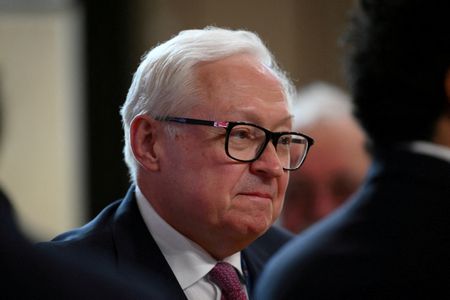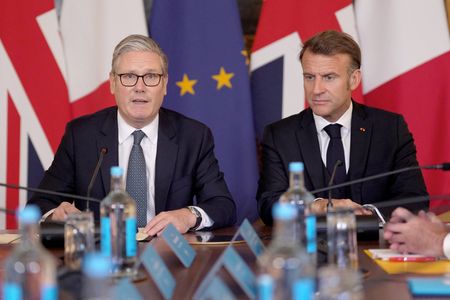LONDON (Reuters) – The Bank of England cut interest rates by a quarter of a percentage point on Thursday, judging a sharp upward revision to its inflation forecasts for this year will prove temporary.
The cut to 4.5% was in line with economists’ expectations in a Reuters poll, but two officials called for a bigger rate cut against a backdrop of weaker growth.
Sterling fell to $1.2370, from $1.2425 just before the decision and was down 1% on the day. It also weakened against the euro to last trade around 83.74 pence compared 83.40 pence earlier.
UK government bond yields fell, with two-year yields last down 4.5 basis points (bps) at 4.08% versus 4.13% just before the rate decision.
London’s blue-chip FTSE and the mid-cap FTSE 250 stock index accelerated their gains and were last up around 1.5% each
Money markets now price in around 67 bps of further BoE easing by year-end.
COMMENTS:
KENNETH BROUX, HEAD OF CORPORATE RESEARCH FX AND RATES, SOCIETE GENERALE, LONDON:
“It’s not helpful for the pound. Firstly, bank staff expected that GDP had fallen by 0.1% in 2024 Q4 and projected that it would rise by 0.1% in 2025 Q1, and secondly there was substantial upside news to the near-term outlook for headline CPI inflation, which is now expected to rise quite sharply in the near term, to 3.7% in 2025 Q3.
“Also, (Catherine) Mann, supposedly the hawk on the MPC voted for a 50 bps cut.”
YAEL SELFIN, CHIEF ECONOMIST, KPMG:
“The Bank of England revised up its inflation outlook, due to near term increases in energy prices, but downgraded its growth forecast for this year on the back of recent weak activity.
“The tone in the minutes signals a clear easing bias for all MPC (Monetary Policy Committee) members and leaves the door open for further interest rate cuts this year. Nonetheless, domestic uncertainty remains with the upcoming tax rises and the increase in the National Living Wage.
“The Bank will assess the second-round effects of these policy changes, and whether they lead to a rebound in domestic price pressures. This will likely mean the pace of cuts will be gradual, and overall, we expect only two further cuts, leaving base rates at 4% by the end of 2025.”
NEIL BIRRELL, CIO, PREMIER MITON INVESTORS:
“The Bank of England cut its base rate to give the economy a boost that is much needed. The fact that two members voted for a 0.5% cut is telling, clearly showing concern over the parlous state of economic growth, which is not something the government will appreciate. With growth under threat and inflation remaining higher than hoped, that provides a combination that is likely to see the word “stagflation” being banded around.”
JEREMY BATSTONE-CARR, EUROPEAN STRATEGIST, RAYMOND JAMES, FRANCE:
“Ebbing inflationary pressures and persistent economic weakness underlie today’s decision… While hard-pressed consumers and businesses will welcome lower rates, the decision comes in response to a sluggish economy – the same which made the Bank of England cut its Q4 GDP growth forecast to zero at its December meeting.
“The combination of weak economic activity and decelerating service sector prices will impart downward pressure on inflation. In contrast, wage growth strength hints at supply-related issues which may take longer to resolve. Given that today’s monetary policy adjustment will have a lagged effect on the economy, time will tell how further rate decisions might play out this year.”
ZARA NOKES, GLOBAL MARKET ANALYST, JPMORGAN ASSET MANAGEMENT, LONDON:
“With December’s softer-than-expected inflation print having fuelled market expectations for a cut, the Bank of England likely felt it had no other choice today. The distribution of votes showed high conviction in the call, yet this approach is not without risks.
“While economic activity is clearly slowing, inflation pressures are not. Inflation expectations have picked up as a result of higher energy prices, strong wage growth and businesses signalling that they intend to charge higher prices in response to October’s tax hike.
“The growth outlook might also not be as bad as business surveys suggest, with the large increase to public services spending announced in the Autumn Budget likely to provide a tailwind to growth this year, offsetting some of the private sector weakness. Against this backdrop, the Bank must be resolute in its commitment to bring inflation back to target.
“Rate cuts might be popular in the short term but, ultimately, there will be a higher price to pay further down the line if inflation is not stamped out now.”
ZSOLT KOHALMI, DEPUTY CEO & GLOBAL HEAD OF REAL ESTATE, PICTET ALTERNATIVE ADVISORS, LONDON:
“Interest rates are crucial to the real estate recovery story. UK rates are currently between the U.S., which are higher, and continental Europe, which are lower.
“For a recovery in the UK real estate market to really take place, though, UK rates need to come down significantly and be closer to the European rate curve outlook, rather than the U.S. For now, this is far from certain, but would be a bonus for investors in UK real estate.”
MICHAEL FIELD, CHIEF EUROPEAN STRATEGIST, MORNING STAR, AMSTERDAM:
“With plentiful equity market opportunities for investors in the UK, we believe further interest rate cuts over the course of 2025 will lighten the load for consumers and businesses alike. This should create a more supportive economic backdrop for commerce generally.”
(Reporting by Reuters Markets Team, Compiled by Dhara Ranasinghe; editing by Amanda Cooper)









